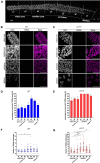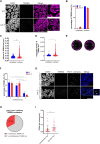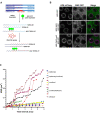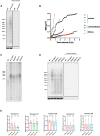TERRA expression is regulated by the telomere-binding proteins POT-1 and POT-2 in Caenorhabditis elegans
- PMID: 37713629
- PMCID: PMC10602879
- DOI: 10.1093/nar/gkad742
TERRA expression is regulated by the telomere-binding proteins POT-1 and POT-2 in Caenorhabditis elegans
Abstract
Several aspects of telomere biology are regulated by the telomeric repeat-containing RNA TERRA. While TERRA expression is conserved through evolution, species-specific mechanisms regulate its biogenesis and function. Here we report on the expression of TERRA in Caenorhabditis elegans. We show that C. elegans TERRA is regulated by the telomere-binding proteins POT-1 and POT-2 which repress TERRA in a telomere-specific manner. C. elegans TERRA transcripts are heterogeneous in length and form discrete nuclear foci, as detected by RNA FISH, in both postmitotic and germline cells; a fraction of TERRA foci localizes to telomeres. Interestingly, in germ cells, TERRA is expressed in all stages of meiotic prophase I, and it increases during pachytene, a stage in meiosis when homologous recombination is ongoing. We used the MS2-GFP system to study the spatiotemporal dynamics of single-telomere TERRA molecules. Single particle tracking revealed different types of motilities, suggesting complex dynamics of TERRA transcripts. Finally, we unveiled distinctive features of C. elegans TERRA, which is regulated by telomere shortening in a telomere-specific manner, and it is upregulated in the telomerase-deficient trt-1; pot-2 double mutant prior to activation of the alternative lengthening mechanism ALT. Interestingly, in these worms TERRA displays distinct dynamics with a higher fraction of fast-moving particles.
© The Author(s) 2023. Published by Oxford University Press on behalf of Nucleic Acids Research.
Figures







Similar articles
-
Caenorhabditis elegans POT-1 and POT-2 repress telomere maintenance pathways.G3 (Bethesda). 2013 Feb;3(2):305-13. doi: 10.1534/g3.112.004440. Epub 2013 Feb 1. G3 (Bethesda). 2013. PMID: 23390606 Free PMC article.
-
Telomeric double-strand DNA-binding proteins DTN-1 and DTN-2 ensure germline immortality in Caenorhabditis elegans.Elife. 2021 Jan 21;10:e64104. doi: 10.7554/eLife.64104. Elife. 2021. PMID: 33476260 Free PMC article.
-
Gametes deficient for Pot1 telomere binding proteins alter levels of telomeric foci for multiple generations.Commun Biol. 2021 Feb 4;4(1):158. doi: 10.1038/s42003-020-01624-7. Commun Biol. 2021. PMID: 33542458 Free PMC article.
-
Telomere elongation chooses TERRA ALTernatives.RNA Biol. 2015;12(9):938-41. doi: 10.1080/15476286.2015.1065374. RNA Biol. 2015. PMID: 26158306 Free PMC article. Review.
-
Telomeric noncoding RNA: telomeric repeat-containing RNA in telomere biology.Wiley Interdiscip Rev RNA. 2014 May-Jun;5(3):407-19. doi: 10.1002/wrna.1220. Epub 2014 Feb 12. Wiley Interdiscip Rev RNA. 2014. PMID: 24523222 Review.
Cited by
-
TERRA transcripts localize at long telomeres to regulate telomerase access to chromosome ends.Sci Adv. 2024 Jun 14;10(24):eadk4387. doi: 10.1126/sciadv.adk4387. Epub 2024 Jun 12. Sci Adv. 2024. PMID: 38865460 Free PMC article.
-
The Altered Functions of Shelterin Components in ALT Cells.Int J Mol Sci. 2023 Nov 27;24(23):16830. doi: 10.3390/ijms242316830. Int J Mol Sci. 2023. PMID: 38069153 Free PMC article. Review.
References
Publication types
MeSH terms
Substances
Grants and funding
LinkOut - more resources
Full Text Sources
Molecular Biology Databases

